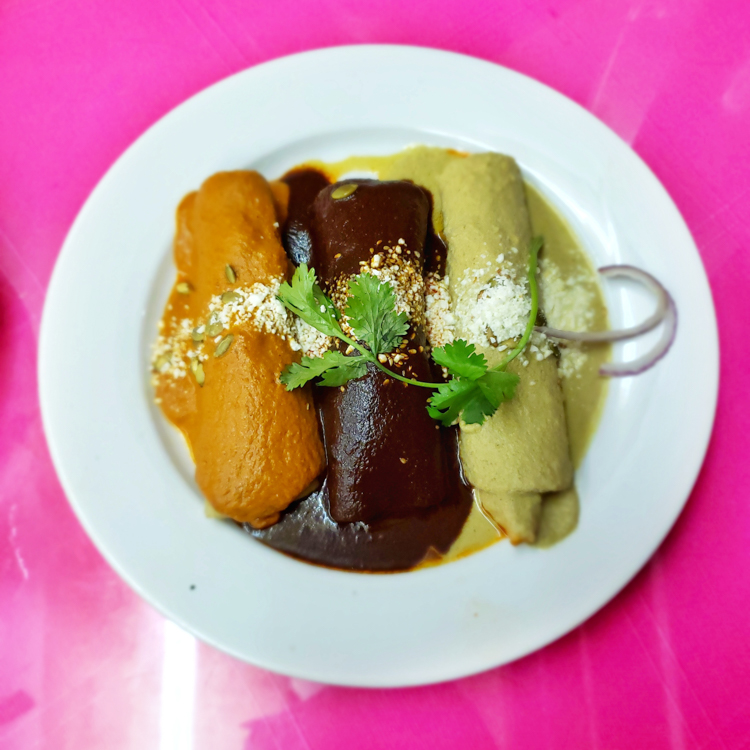Los Angeles is a city defined by neighborhoods you move through. But it’s hard not to feel isolated and stuck in your bubble. We created this guide, in partnership with Lime, to spotlight the tried-and-true spots that tie locals together.
[dropcap size=big]L[/dropcap]os Angeles may be the entertainment capital of the world, but to many outsiders that means it's some kind of factory town: a place where films and records are mass-produced before being exported across the globe for further consumption.
In truth, many of L.A.’s most vibrant cultural and creative scenes never get packaged for a mass market. Certain pockets of the city are highly regarded for precisely the types of artistic expressions that are ephemeral by nature –– impossible to capture and record, much less turn into a shippable product. Leimert Park brims with these in-the-moment experiences that don't fit neatly onto postcards or press releases.
Take Project Blowed. Founded in 1994 as the spiritual successor to the Good Life Cafe, a famous open mic night in South Central Los Angeles, the Blowed became a place where rappers––legends, soon-to-be legends, and aspiring amateurs––congregated every week to share what they’d been working on, hone their craft, sharpen their freestyling skills, and create an electric environment where styles clashed and evolved. The weekly event, which continues today, attracts fans of all types from all across the city (and country) and counts Kendrick Lamar, Ice Cube, and Lenny Kravitz among its fans.
It’s no surprise that the meeting grounds for some of L.A.’s most compelling hip-hop is in Leimert Park; the neighborhood is a mecca of sorts for black culture in the city. Founded just before the Great Depression, Leimert became an oasis for those looking to play or listen to jazz and the blues. It is where Ray Charles lived when he first moved to Los Angeles––across the street from a home believed to have belonged to Ella Fitzgerald.
Although you seldom see the neighborhood depicted in writing or film, it is one of L.A.’s most vital expanses, far from Hollywood or the beach but no less integral to the city’s fabric. Something the late, great director John Singleton noted when he called Leimert Park “the black Greenwich Village.”
That legacy is reflected today in the California Jazz & Blues Museum and the near-adjacent Performing Arts Center, both of which were founded and are still run by Barbara Morrison, a professor of Jazz Studies at UCLA and renowned vocalist in her own right. Morrison’s projects serve as a hub for those looking to understand the deep California roots that stretch into those genres and to brush up against the strange and exhilarating directions they’re taking in the present. That relationship to time is, in fact, one of the most remarkable things about Leimert: there’s a connection to the past that doesn’t feel like revivalism or anachronism, but rather like constant regeneration.
While L.A. has no shortage of places to watch movies, Leimert’s Vision Theatre has evolved into something more. The iconic building, which was constructed as a “movie palace” in 1931, has been renovated to support performing arts of all kinds—an oasis between freeways.
Leimert Park feels distinct from surrounding parts of South L.A. Nor does it mirror Mid-City, Inglewood, or nearby Baldwin Hills. It’s a singular pocket of an otherwise vast city charged with revivalist passion and eccentric swaths of subcultures. Although you seldom see the neighborhood depicted in writing or film, it is one of L.A.’s most vital expanses, far from Hollywood or the beach but no less integral to the city’s fabric. Something the late, great director John Singleton noted when he called Leimert Park “the black Greenwich Village.”
As for the culinary options: Leimert is famous for hosting some of California’s best Jamaican food, including Ackee Bamboo, which is renowned for its oxtail, plantains, and jerk chicken.
And in an era when books are increasingly purchased after a series of blind clicks through online retailers like Amazon, Leimert throws readers back to a time when bookstores were central to intellectual communities—a place where people could talk to one another, share recommendations or experiences and discover the unexpected. There are roughly 110 black-owned bookstores in the United States; of those, Leimert’s Eso Won Books is one of the oldest. In addition to its unique stock of writers, the store hosts a variety of community-focused events throughout the year. The renowned author Ta-Nehisi Coates called it his favorite place to buy books, and Barack Obama, who lived in Los Angeles County during his undergrad years, staged a reading at Eso Won before his presidency.
As for the culinary options: Leimert is famous for hosting some of California’s best Jamaican food, including Ackee Bamboo, which is renowned for its oxtail, plantains, and jerk chicken. Worldwide Tacos on Martin Luther King Jr. Blvd often has hour-long lines for its globally-inspired Mexican eats. The fare at Delicious Southern Cuisine is as advertised; Harun Coffee is such a hot spot that celebrities as big as Rihanna have gravitated to its small white space. Nearby in West Adams, Revolutionario is that rare Northern African taco stand run by a French fine-dining chef, while Bee Taqueria specializes in taco omakase dinners that let imaginations in the kitchen run wild.

The horseshoe shape the neighborhood forms around Leimert Park Plaza gives it the feel of an open-air market on sunny days, the kind of place where the community comes together for invigoration, interaction, and respite. In some parts of the city, homes and businesses sit so far from one another that people remain walled off in their own little worlds; Leimert Park is among the exceptions, pushing people out of isolation and into an interconnected world.
But for now, Leimert seems to exist somewhere out of time, suspending art and culture in amber, protecting their purity from the decay and commodification so common in the outside world. It’s impossible to export or replicate Leimert Park—which is precisely why experiencing it is so essential.
Even pieces of the landscape that might be window dressing in other areas are astonishing here: murals rendered with remarkable intricacy, fences adorned with blocks-long patterns, geometric figures etched into the sidewalk. Beyond the quality of each individual work are the overarching ideas that public spaces can be bettered for the public good through art that has value to the community without being commoditized. This is the soul of the neighborhood, its distinct atmosphere and character derived from something other than commercial venues.
Leimert Park faces the same uncertain future lying in wait for every major urban neighborhood. The whims of the real estate world, opaque development plans, and other political and market forces threaten sweeping change with little warning.
But for now, Leimert seems to exist somewhere out of time, suspending art and culture in amber, protecting their purity from the decay and commodification so common in the outside world. It’s impossible to export or replicate Leimert Park—which is precisely why experiencing it is so essential.

The Lime x L.A. Taco guide to Leimert Park
The Lime x L.A. Taco guide to Venice & Santa Monica







